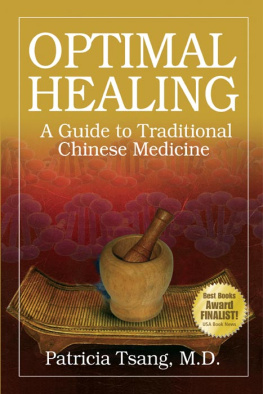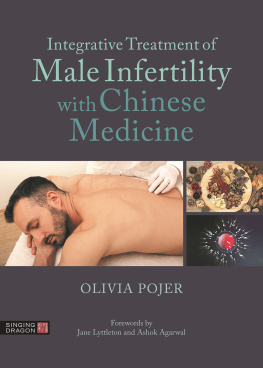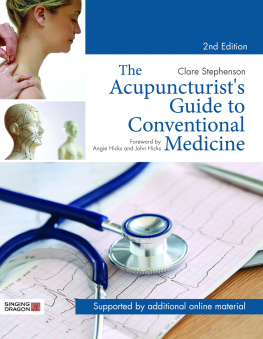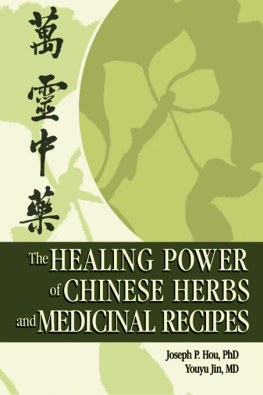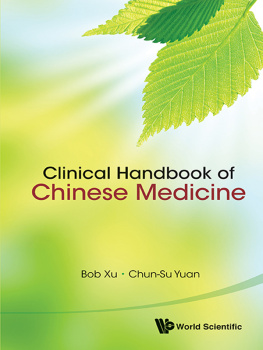
Balance for Health Publishing
3701 Sacramento St. #407
San Francisco, CA 94118
www.balanceforhealthpublishing.com
The material set forth in this book is for informational and educational purposes. It should not be construed to constitute medical advice or to replace consultation with a qualified healthcare provider for diagnosis and treatment of illness or disease.
2008 by Patricia Tsang, M.D.
All rights reserved, including the right to reproduce this book or any portion thereof in any form.
Publishers Cataloging-in-Publication
(Provided by Quality Books, Inc.)
Tsang, Patricia.
Optimal healing: a guide to traditional
Chinese medicine / Patricia Tsang. 1st ed.
p. cm.
Includes bibliographical references and index.
1. Medicine, Chinese. I. Title.
R601.T73 2007 610.951
QBI07-600235
Book cover and interior design by 1106 Design
Illustrations by Jennifer Suehs
ISBN: 978-0-9799484-9-7
Library of Congress Control Number: 2007907373
To my teacher,
Yat Ki Lai, L.Ac., O.M.D.
Dr. Tsang has done an outstanding job of interpreting the ancient practice of TCM into contemporary Western medical terms. She does this in a very accessible and engaging manner, weaving in case examples that bring the practice of TCM alive.
Priscilla Abercrombie, RN, NP, PhD, Assistant Clinical Professor
UCSF Department of Ob/Gyn and Reproductive Science and
Community Health Systems Nursing
A superb overview that will enable patients, students, and health professionals to better understand Traditional Chinese Medicine and its integration into Western medical practice. The book is lucid and engaging, filled with personal examples that draw in the reader and help clarify the often strange-sounding TCM terms, while providing specific information on diagnosis and therapy. The author is a Western trained physician who later learned TCM and integrated it into her practice, way before it became as fashionable as it now is. I think this would be a terrific book for every new student of acupuncture and Oriental medicine to read as they begin and then continue their studies.
Gary M Arsham, MD, PhD
Chair, California Pacific Medical Center Institutional Review Board
Member of Advisory Board, Seattle Institute of Oriental Medicine
Co-author of Diabetes: A guide to Living Well and 101 Tips for Coping with Diabetes
In Optimal Healing, Patricia Tsang offers an informed exploration of traditional Chinese medicine (TCM) and its interface with Western biomedicine. She writes as a board-certified anesthesiologist who has also made an intensive study of TCM. The book is filled with acute clinical observations, scientific findings, and probing analysis of the research opportunities in TCM that would greatly expand our understanding of human healing.
Michael Lerner, PhD, president, Commonweal
Author of Choices in Healing: The Best of Conventional and
Complementary Approaches to Cancer
From reading this marvelous book, written by a physician trained in both Western and Eastern medicine, I have gained a basic understanding of herbal and acupuncture treatments. With this new knowledge, I can now better relate to my patients who have been successfully treated with complementary approaches. I also found the section on foods and diet enlightening. I recommend it for every practicing physician as well as every medical student.
Cynthia Point, M.D. internist, San Francisco, AOA,
member ACP, Best Doctor category Internist 2000, 20022007
This is a landmark book that bridges the gap between Eastern and Western medicine. It truly demystifies traditional Chinese medicine. I appreciate how the author has set straight that there are stages to disease and a best time to use Eastern versus Western medicine.
Derrina Wu, M.D., internist
San Francisco
Preface
T he first five chapters of this book are devoted to translating the mystical-sounding terms used in traditional Chinese medicine into familiar contemporary language. I take you into the classroom at the American College of Traditional Chinese Medicine as I listen to the lectures and ponder their meaning. The lecturers words are italicized. The lectures were delivered in Cantonese by Ken Pang, L.Ac. and translated into English by Sifu Fong Ha, a martial arts master. The material was compiled from both ancient classic literature and contemporary traditional Chinese medical books.
In traditional Chinese medicine (TCM), organs often represent several physiologic systems rather than the organs as we know them. Whenever used in the TCM sense, these organs, mainly the Liver, Kidney, and Spleen, have been capitalized to distinguish them from the organs we know as the liver, kidney, and spleen.
Causes of disease in TCM are classified according to the six evils: Cold, Fire, Summer Heat, Dryness, Wetness, and Wind. These terms likewise are capitalized when used in the TCM sense. TCM conditions, or symptom patterns, are classified according to the eight entities: Yin, Yang, Hot, Cold, Internal, External, Solid, and Deficient. They represent four pairs of dualities and, when used in this context, are also capitalized.
Terms in Chinese can have several English translations. Liver Fire uprising can also be called Liver Fire, Deficiency Fire, or Insubstantial Heat. Regarding the Six Evils, Dryness is sometimes called Parchness; Wet is sometimes translated as Damp. Regarding the eight entities, Deficiency is also known as Vacuity. The term Mobilizing Qi and Blood is interchangeable with Vitalizing Qi and Blood.
From the sixth chapter on, after having explained the meaning of TCM terms, I go on to explain the TCM paradigm, point out how it differs from the Western paradigm, and demonstrate its relevance in my contemporary integrated practice. The case studies are all true, but the patients names have been changed to protect privacy.
Introduction
O ne day, after I performed acupuncture on a new patient, she told me, Im disappointed. I expected your office to have beaded curtains and more of an Asian aura. Your treatment room is just like any other doctors office. The Western stereotype of Chinese medicine dies hard. The media tend to cover stories about acupuncture by focusing on its mystical appeal. In television segments the camera is pointed at patients with needles protruding from their faces. Exotic music plays in the background. A practitioner pronounces an incantation that no one, possibly not even he himself, understands: The problem is that your Qi is obstructed.
While the romantic in us is drawn to magic shows and the like, if we perpetuate a romanticized view of traditional Chinese medicine (TCM), we forfeit a multitude of benefits. But if we strive to understand this ancient system of healing, we can learn about disease prevention, find ways to resolve many chronic intractable conditions, and contain health-care cost. The purpose of this book is to demystify TCM by translating its terms into familiar language, explain its unique paradigm, dispel some common misconceptions about it, and recommend ways in which it can be used to complement Western medicine.
Many of the mystical-sounding terms used by traditional Chinese practitioners actually have concrete meanings. The terms sound strange because they are over three thousand years old, originating at a time when there was little knowledge of anatomy, physiology, or microbiology. Each term, though, represents some physiological phenomenon. As a Western-trained physician who experienced healing from an intractable condition using Chinese herbs, I became interested in TCM, studied it, and actually put this system to use in my practice of family medicine. By doing this, I have been able to help many patients whose conditions were considered hopeless. My explanations cannot be found in any existing reference books. They are the result of my studying English translations of the ancient Chinese texts, wrapping my Western-trained mind around the odd-sounding terms and concepts, finding Western equivalents for them, and ultimately applying the teachings to treating patients.
Next page
